Official Prohibitions of Hotel Life, 1930–1970
While some urban changes informally influenced hotel residents, other changes—most of them officially devised within various phases of urban renewal—aimed directly at the eradication of hotel life. Urban renewal accomplished many important things, but it also deservedly earned many critics. In most cities, renewal was racially biased; renewal often lined certain landholders' or contractors' pockets more than it should have; building the new downtown frequently became an exercise in personal empire building at the service of the downtown business elite. Urban renewal was also a period of hotel resident removal. Hotel housing was absolutely foreign to the aims and legal limitations of public housing. During the decades of urban renewal, officials moved from making antihotel policy to attempting to eliminate hotels; this prohibition was part of their scheme to end all urban blight and poor housing.
The assumptions behind the planned elimination of residential hotels seem to have been very much like the notions behind the national Volstead Act and its attempt to eliminate all alcoholic beverages. Prohibitionists assumed that if they took away the supply of a mistrusted part of the material culture, then the use and need would end as well. Just as the stubborn public refusal to give up drinking hindered the intended social benefits of the Volstead Act, so too the continued existence of hotels seemed to block the promise of the new city. These policies provided major fuel for the later SRO crisis.
Definitions of Blight as Condemnation
The rebuilding programs that preceded full-scale urban renewal were of modest scale. During the New Deal, demolition was typically done lot by lot in keeping with the federal policy of equivalent elimination. The idea was to remove slum housing at exactly the same rate that public replacement housing was built. For each new public housing unit completed, a dilapidated housing unit elsewhere had to be condemned, repaired, or demolished.[18] Ironically, hotels escaped early public demolition because only accepted housing units (those with private kitchens and baths) could be considered for equivalent elimination.
The idea of blight, however, helped post-World War II planners do wholesale bulldozing of U.S. hotel stock. The concept of blight (as opposed to the concept of a slum) summed up the officially perceived problems of the old city. Hoover's 1932 Conference on Home Building and Home Ownership defined a slum as an area of social liability; that same area, the panel concluded, might continue to be profitable for its owners. A blighted area, however, was an economic liability—a district whose property values were so depreciated that they returned less in taxes than they cost in public services. By the late 1930s, downtown landowners were particularly concerned about depressed property values in hotel areas. Politicians worried about such zones because of their reduced tax revenues and high costs of services. The Hoover conference's committee on city planning and zoning used cheap hotels and mixed uses as their prime examples of neighborhood blight.[19]
The 1945 law that enabled urban renewal in California required that blight be demonstrated before clearance, and it gave a multipage definition that planners summarized as follows:
[Blighted areas are] areas compactly built . . . with indiscriminate mixtures of industry, business, and housing, having large percentages of substandard dwellings and absentee ownership, lacking adequate open spaces, play grounds, and gardens, and presenting ugly, depressing vistas on the public streets.[20]
Greenery and designerly vistas were to be preferred over any old city social values.
During the New Deal, the areal extent of blight had been detailed by real estate experts working on real property surveys. In San Francisco's survey, completed in 1939, the majority of substandard dwellings were so classified because they contained shared toilets or baths. Forty percent of the Western Addition's population (50,000 out of 86,000) shared baths or kitchens with other households. In a 1935 survey, 80 percent of the Western Addition's units had been found in good repair. Thus, dilapidation was not generally a problem. However, by 1946, the cost of police service to the area was reported to be ninety times that of newer middle-income areas.[21] In the official maps of blighted areas, different sorts of hotels fared differently. In 1939 and 1945, the mid-priced hotels and better rooming houses of the Tenderloin area were not marked; these postfire structures were of masonry construction, had good plumbing, and were still profitable. For the same reasons, the two blocks directly south of Market Street also fared well. The blocks of the waterfront, Chinatown, the Mission district, and South of Market—with many wooden buildings and far more mixed uses—fared worse (fig. 9.7). Predictably, blight and proposed condemnations were thickest in the Western Addition.
In 1945, the federal bulldozer was not yet at the door in San Francisco, but it was on its way for the vast majority of SRO rooms. "No amount of enforcement can change blighted neighborhoods," wrote one planner about San Francisco after World War II. He continued, "Nothing short of a clean sweep and a new start can make the district a genuinely good place in which to live."[22]
Nonbuilding as Eradication
The clean sweep of hotels came not only with the tearing down of former single-room districts but also with the decisions about what types of buildings should fill the empty
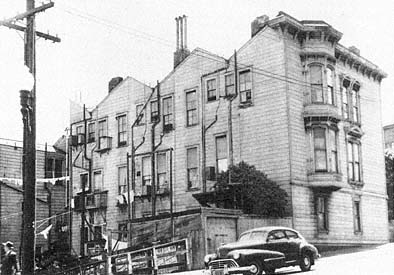
Figure 9.7
Reformer's-eye view of rooming houses in San Francisco, 1947. One local
newspaper published this picture, which shows the back of the structure,
with the caption, "Exterior of typical Western Addition Rooming House."
The house was four blocks from City Hall.
blocks. That is, the official prohibition of hotels entailed both clearance and nonbuilding , active refusal to build, repair, or subsidize residential hotels with public funds. Publicly funded housing of World War I and World War II had included hotels and dormitories, although for the most part these were temporary structures. Nonbuilding had become officially ordained with the establishment of the Federal Housing Administration during the New Deal. Through the 1970s, the federal government funded or assisted virtually no hotel-style public housing other than college dormitories and too few studio apartments that might have replaced midpriced hotel housing.[23]
In concert with federal policy (which in turn was tied to federal funding), local bureaucracies in charge of rebuilding downtown usually had to avoid the construction of hotel housing. San Francisco established its city housing authority in 1938, and its foremost priority was to build suburban-style apartments for urban families—putting the idealist strategy into concrete. The authority's first three projects were three-story walk-up garden apartment buildings set in ample open space.[24] After the war, in 1945, came the time for larger-scale work. As experts were doing in other states, California city officials convinced the legislature to give special city authorities the power for complete urban renewal: designating blighted areas, replanning and replatting the blocks, and (unlike the New Deal scheme of public construction and management) then selling the land to private developers.[25]
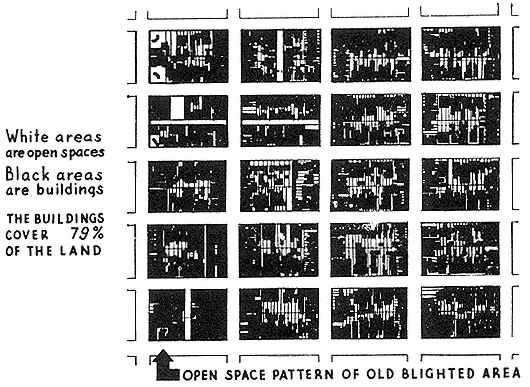
Figure 9.8
Map of an urban renewal study area, drawn to emphasize the density of San Francisco's inner
Western Addition, 1945. From a report of the City Planning Commission.
San Francisco's first clearance under the new rules was to be in the Western Addition; it was to be a total redevelopment initially slated for 280 city blocks. In a widely circulated 1947 report commissioned by the city Board of Supervisors, planners and architects developed a detailed plan for a study section nearest the civic center and downtown (figs. 9.8, 9.9). At the time, the Western Addition clearance was correctly criticized as "Negro removal," but the project was also hotel housing removal. In 1947, the planners still assumed a single developer would rebuild the study area. The staff, the planning commission, the supervisors, and the mayor agreed that the neighborhood demographics were to remain the same. Out of 445 hotel units existing in the area, the experts liberally proposed to keep 200. Yet out of the 3,799 new housing units they proposed to build, none were hotel units. Of the households throughout the Western Addition, 36 percent were to continue to consist of one person, with a much higher proportion of single households in the blocks close to downtown, like the study district. Thus, the sample area plan called for 56 percent of the new units (2,139 out of 3,799) to be two-room efficiency apartments consisting of a sleeping-studio room, an adjoining kitchen-dining room, and a bath-
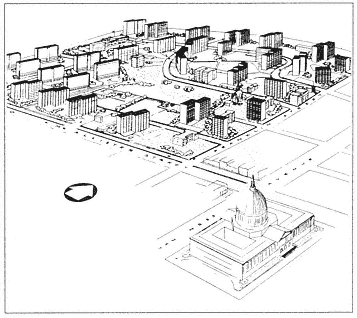
Figure 9.9
Proposal for the inner Western Addition, suggesting removal
of the old housing and replacement with single-use public
housing towers. San Francisco City Hall is in the foreground.
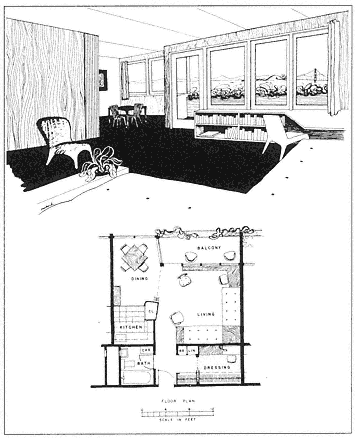
Figure 9.10
An idealistic SRO upgrade proposal, 1947. As rooming houses
were torn down, efficiency apartments like these were
originally envisioned for the rebuilt Western Addition.
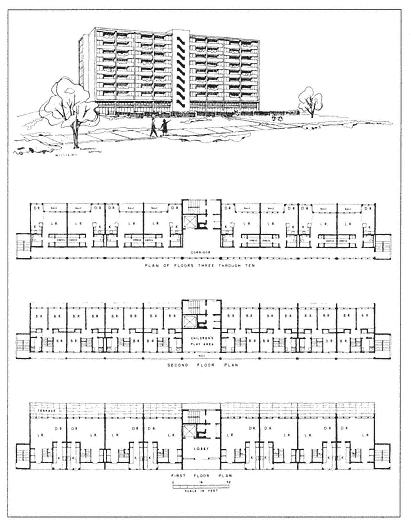
Figure 9.11
Apartment towers proposed for the Western Addition, 1947. The eight
upper floors were to be efficiency apartments that would replace
rooming house units. At the lowest level were two-story town
house units for larger households.
room (figs. 9.10, 9.11).[26] This very liberal proposal was in effect an idealistic SRO upgrade.
The 1947 proposal was part of a strategy to establish the city's redevelopment agency, which was founded in 1948. Mayors hostile to renewal prevented the San Francisco Redevelopment Agency (SFRA) from acting in any significant way from 1952 until 1959.[27] During the seven-year hiatus, changes at both the local and federal levels meant that the idealistic scheme for rehousing of the Western Addition's residents was largely lost. By the 1960s, the urban renewal plan for the district was very different. For market rate housing, the mix of unit types was left to the discretion of individual developers. For housing
with public subsidies, the programs themselves usually dictated larger units for larger families; heavy-handed administrative pressure from Washington also pushed the mix toward one- and two-bedroom units and away from studio units. For the first phase of redevelopment, data from 1971 show that only 16 percent of the units were studios or efficiencies—in a city where over half of the people waiting for public housing were single elderly people who needed small units. In the second phase, the SFRA's own study found that more than 4,000 of the displaced households (61% of all households) were single-person and more than half, nonwhite. Data on apartment-size mixtures are strangely not available for this phase of the redevelopment, but the proportion of studio units was probably less than 16 percent. Meanwhile, deliberate ignorance continued unabated. A thorough 1967 interagency report on San Francisco's housing did not mention SRO or other hotel units in the city.[28]
Other proposals were more radical than the 1947 San Francisco proposal and even less successful in gaining either local or federal approval. An earlier proposal, one which probably inspired the San Francisco planners, was made during the New Deal by Harvard professor James Ford. For New York City he suggested huge new SRO replacement hotels within larger housing projects. Ford was concerned not only for single people in existing hotels but also for the estimated 200,000 lodgers who lived with New York families. Ford argued that if proper quarters were available for the lodgers, then they would not crowd into the new family housing. For potential housing sites both on the Lower East Side and in Harlem, he recommended interspersing tenstory elevator buildings for family housing with similarly scaled SRO buildings. According to his scheme, some of the SRO structures would have been segregated by gender; others were to accommodate men and women on separate floors; still others would have contained small efficiency apartments in addition to single rooms. He also advocated rehabilitating New York's existing rooming houses. Even in the heady days of New Deal experimentation, however, Ford's ideas had been flatly rejected.[29]
In 1952–53, Catherine Bauer and Davis McEntire proposed that the Redevelopment Authority of Sacramento build an entirely new SRO workers' district at a new location to clear the city's West End skid row for more upscale uses. To house the state's largest agricultural
labor pool, Bauer and McEntire suggested 3,000 cubicle rooms of relatively permanent occupancy and 1,500 dormitory beds for migrants, all built above commercial spaces, all to be owned by the city and leased to private managers. At the going rates of 75 cents per night and $7 per week, the project would have been largely self-supporting. Bauer and McEntire admitted they were up against extant federal policies, especially Section 207 of the National Housing Act (which recognized only rental units "of design and size suitable for family living"). Sacramento's redevelopment agency actually concurred with the plans, and several private developers were interested in Bauer and McEntire's proposal. However, the difficulties of finding cheap land and the lack of appropriate federal programs killed the brave project.[30]
The proposals for San Francisco's Western Addition, Ford's SROs in New York, and Sacramento's West End were exceptions in the general tide of urban renewal ideas but not rarities. Their existence proves that at least some local leaders and housing designers saw the continued need for and viability of hotel housing, or something very close to it. Yet, the official nonbuilding policy for hotel projects, especially after the mid-1950s, reveals how monolithic housing policies were. The vast majority of public housing proposals gave only lip service to oneperson households, in large part because needs for larger households were equally or more pressing, politically more visible, and keyed into the doctrinaire single focus on the family. While public programs avoided building new hotel units, parallel actions by many of the same agencies were destroying existing residential hotels.
Making Tenants Invisible
As with the SFRA's applications of blight and nonbuilding, the actions of other hotel-closing agencies were not (in their own minds) aiming the wrecking ball at the homes of the poor but "eliminating dead tissue," "applying the scalpel," "clearing away the mistakes of the past," and building "an attractive new city." About a Norfolk, Virginia, hotel district, one planning journal editor reported in 1961 that "progress had reached the demolition stage." Local agents crowed that they had "reduced to rubble . . . scores of flophouses not renowned for adding luster to their city's good name."[31]
Because officials did not consider hotels to be permanent housing, during the official massive downtown clearances from 1950 to 1970, people living in hotels were not tallied as residents. Hence, when a
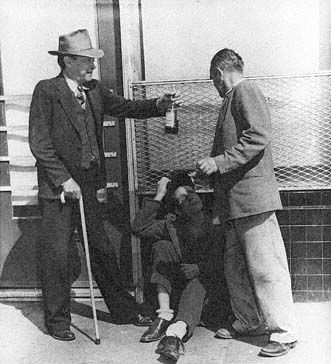
Figure 9.12
Helping to make skid row residents look bad, 1956. This picture
of a bottle club in the South of Market was carefully posed
by a San Francisco newspaper photographer. Fostering
such stereotypes lessened concern about SRO demolition.
city demolished an SRO building, "no one" had been moved, and no dwelling units were lost in the official counts and newspaper reports (fig. 9.12). In reality, of course, hundreds of thousands of SRO people and homes were being removed. Deliberate ignorance had become a cultural blind spot that made hotel residents invisible both to officials and to the public. A 1970 planning study in San Diego found only 100 people living in the city's large single workers' district, which was being considered for demolition. Local hotel housing advocates protested. A second count in 1975 found 499 people in the same district; after another protest, a third count found 1,000 hotel people still living in the district—and this after several hotels had closed because of the official pressure. In some cities, the people removed were difficult residents: bums, psychotics, or other marginal people. But the vast majority were not marginal. By making them invisible, experts made the rough handling of such people easier.[32]
Relocation costs gave city officials another reason to make hotel residents invisible. The 1961 Housing Act provided up to $200 for a family displaced by renewal but gave no guidelines and granted no federal funding for single individuals. To fill that gap in the law, the Urban
Renewal Administration in Washington authorized local authorities to pay each single SRO person a relocation fee of $5, approximately cab fare out of the neighborhood. "Transients," those who had lived fewer than ninety days at a hotel, did not even qualify for the $5, although many local agencies paid the token relocation fee to any SRO tenant who applied.[33]
In San Francisco's redevelopment of the South of Market, politicians and downtown leaders deemed a large clearance was necessary for what eventually has become the huge Moscone Convention Center and its adjacent Yerba Buena Gardens. In the blocks to be cleared during the 1960s, 91 percent of the households were single, and most were white; 97 percent lived in hotels. A surprising 41 percent of the 240 families in the renewal area also lived in hotels. Later studies estimated that about 40,000 hotel rooms were destroyed, although city officials kept no tally.
Initially in areas like the Western Addition and South of Market, the opposition of hotel residents was neither strong nor organized. Instead of fighting a seemingly impossible battle, tenants took their $5 relocation fee and moved. To their credit, the staff in many urban renewal agencies attempted to give SRO tenants help in finding a new home; in some cases, the appointed social workers made repeated visits and multiple notices. The SRO residents, tending to be fiercely independent and suspicious of authorities, usually had ample reason to mistrust overtures from urban renewal agents. In any case, up until the early 1960s the vast majority of the tenants moved on their own, without help. Long after the supply of inexpensive SRO housing had reached a critical stage, these tenants still thought they could find a new place.[34]
In the late 1960s, hotel tenants met increasing frustration in finding rooms. The losses in rooms had far outpaced the losses in clients. No national figures exist for the number of SRO hotel rooms destroyed before 1970; estimates usually refer to "millions" of rooms closed, converted, or torn down in major U.S. cities. Including the hotels closed in small towns and medium-sized cities would double the number of units lost.[35] Alarmed by the simmering political and health implications of relocation and the declining quality of life in inexpensive hotels, a few pioneering planners, social workers, public health officials, and journalists recognized the beginning of an SRO crisis.[36] During the 1960s, this new corps of SRO advocates began to chip away at the unfair
stereotypes about hotel life. Their work coincided with a growing professional and public disillusionment with downtown renewal. The publication of books such as The Death and Life of Great American Cities in 1961, The Urban Villagers in 1962, and The Federal Bulldozer in 1964 had galvanized critiques of urban renewal processes and goals.[37] Among housing officials and planners, the time was ready for a more widespread change of heart about hotel life. Unfortunately, for many hotel residents, this revised view would be too late.